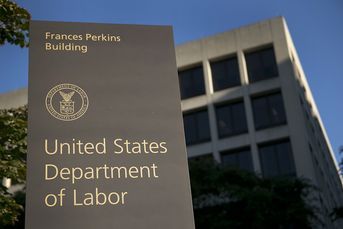Will employers pass the college planning test?

As federal student loan payments resume, parts of the SECURE 2.0 Act will soon make it easier to save for college or contribute to a 401(k).
Paying for college is seldom easy, and there are several factors at play that will soon make planning for it simpler and harder in their own ways.
Next year, provisions from the SECURE 2.0 Act take effect that will allow employers to offer some financial benefits to workers who are paying down student loans. But that much-anticipated development comes as payments on federal student loans have resumed after a 3½-year hiatus and as the government has delayed publishing its 2024 federal student aid application form.
Another aspect of the legislation is that it will soon allow rollovers from 529 savings plans to individual retirement accounts, which gives parents and grandparents a considerable incentive to open such accounts.
ABOUT THOSE REPAYMENTS
Employers – or at least their human resources departments – are very much aware of the financial stress that the resumption of federal student loan payments will cause for some of their workers. Repayments started again in October, following the pause during the pandemic that was extended several times. Those payments will likely hit the youngest workers hardest, as many have never had to make payments before and will have to adjust their budgets accordingly.
Recent surveys from Fidelity and Empower have found that some workers will be in a financial bind because of the repayments, and that could affect participation in company 401(k) plans.
Starting next year, there will be a way around that. Employers that provide matching contributions for their workers will be able to do so for those who aren’t contributing to plans on their own but are paying down student loans. Numerous retirement plan record keepers are adding that capability to their systems, and newer companies like Candidly and Vestwell’s Gradifi offer such programs.
“There is a lot of attention in the prep stages to get that in place,” said Kevin Walker, president of Candidly. “It’s a way to unlock money that is being left on the table by people who are not contributing to their 401(k).”
The firm has quickly been ramping up, having expanded business by a factor of 10 over a year, company CEO Laurel Taylor said in August.
HELPING CLIENTS PREPARE
Not only do those programs provide a financial benefit for employees, but employers have incentives to implement them as well. For example, making matching contributions on behalf of those with loan payments can help companies pass “nondiscrimination testing” for their plans, meaning that the 401(k) doesn’t disproportionately benefit higher-income workers, Walker said. It’s also seen as a perk that can help with retention, he noted.
Ahead of the launch in January, the company has been helping clients prepare, providing webinars for employers about how it will work.
But there has been a lot of feedback so far from employees at those companies – both those with and without student loans, Walker said. People without debt are often looking for guidance on how to save for their children’s or grandchildren’s educations, he noted.
Candidly initially entered the market by providing guidance on student debt, such as information about payment options. With federal loan payments resuming, there has been more demand for that, Walker said, including help sought by some nonprofits and health providers to get employees on track for public-service loan forgiveness, he said.
Although President Joe Biden issued an executive order that would have forgiven up to $20,000 in loans for borrowers, that order was reversed by the Supreme Court earlier this year. In response, the administration rolled out a new but limited forgiveness program and income-based repayment options.
Guidance on those topics has also been in demand by employers, Walker said.
“There is still anxiety about understanding what their [repayment] options are,” he said.
COLLEGE SAVINGS
One of the latest reasons that 529 plans have been growing in popularity is that they can be used for private K-12 or vocational training expenses. Adding to that flexibility, the assets can potentially be rolled over to a Roth IRA, which helps reduce the risk that the money has nowhere to go if beneficiaries don’t need it, for example, if they receive full-ride scholarships or don’t attend college.
“The overall outlook for 529s continues to brighten, and especially with the expansion of qualified expenses to certain types of rollovers from 529s to Roth IRAs,” Paul Curley, associate director of 529 and ABLE solutions at ISS Market Intelligence, said in an email. “As 529s expand from a product for education financial planning to retirement financial planning in 2024, we expect new energy by new stakeholders to drive growth.”
Net assets in 529 programs grew by nearly 12% over a year as of the end of the third quarter, going from $365.5 billion to $408.6 billion, according to ISS data published Nov. 9.
ALL ELSE BEING EQUAL
There are a variety of 529 plans on the market, and some are much better than others in terms of cost and investment selection.
The two plans rated highest by Morningstar, according to a report the company issued Nov. 2, are the Utah my529 and Pennsylvania 529 Investment Plan.
The former has received Morningstar’s gold-medal designation since it began rating 529s in 2012, although that plan “does not rest on its laurels,” manager research analyst Hyunmin Kim wrote in the firm’s report.
“State oversight continues to be top-notch. Instead of hiring an investment manager for the plan, the state employs its own well-resourced and experienced investment team and draws upon a network of experts, including its board, an investment advisory committee comprising institutional investors and advisors and external consultants,” Kim wrote.
At $20 billion in assets, the Utah 529 is the fourth-largest plan, behind the Nevada Vanguard 529 Plan ($29.8 billion), the New York direct-sold 529 ($35.2 billion) and Virginia College America 529 ($78 billion), according to ISS figures.
Meanwhile, the Pennsylvania 529, which went up in its rating by a notch this year, benefits from the state treasury’s having built a strong team of investment personnel, who recently negotiated with the investment manager and program manager for a faster rate of fee reductions as total money in the plan increases, Kim stated.
Across the industry, college-savings plans have generally been improving, with lower overall costs and portfolios designed to better fit beneficiaries’ needs. As interest in the plans has grown, asset managers have dedicated more resources to the area, which has benefited participants, Kim noted.
“Stewardship standards continue to rise as well,” she said. “Robust interaction between the state and its investment entity forms a baseline now, with more engaged state entities aggressively negotiating with external managers and advocating for their account holders.”
Here are the latest tools advisors need to improve the client experience
Learn more about reprints and licensing for this article.








